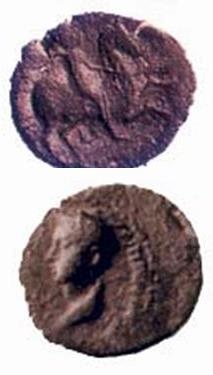Banias Coin, c. 80 CE
This coin minted at Banias may depict the man who employed the expert stoneworkers- Agrippa II—the great-grandson of Herod the Great—who appears here on horseback as a youth, and in profile.
Banias is known as Caesarea Philippi in the Gospels, which describe Jesus and the apostles visiting the “region” or “villages” of Caesarea Philippi (Mark 8-27–30; Matthew 16-13–20). The modern name, Banias, comes from the Arabic pronunciation of the site’s most persistent Greek name, Paneas, a reference to a nearby cave and springs, dedicated as a sanctuary to the god Pan (the p becomes b in Arabic).
“Banias Dig Reveals King’s Palace,” John F. Wilson and Vassilios Tzaferis, BAR 24-01, Jan-Feb 1998.




